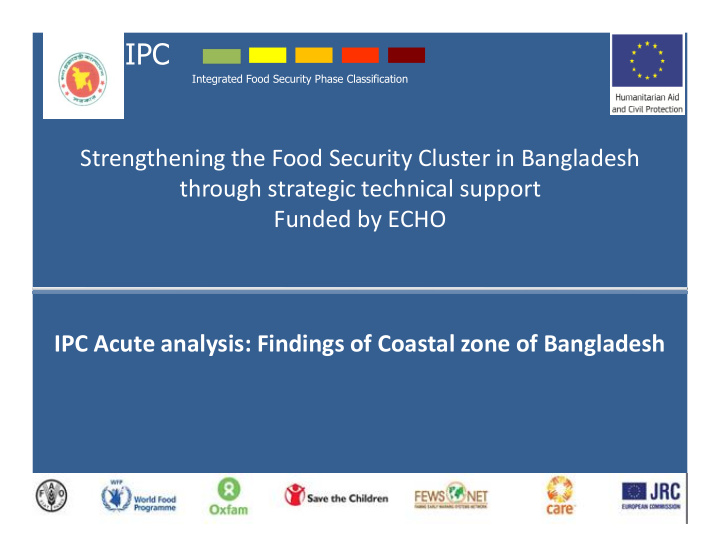



IPC Integrated Food Security Phase Classification Strengthening the Food Security Cluster in Bangladesh through strategic technical support Funded by ECHO IPC Acute analysis: Findings of Coastal zone of Bangladesh
Prepared by Feroz Ahmed IPC National Coordinator- FAOBD IPC analyst & Facilitator E-mail: feroz.ahmed@fao.org September 02, 2013 2
What is the IPC? A set of protocols to classify the severity and causes of food insecurity and provide actionable knowledge by consolidating wide-ranging evidence A process for building technical consensus among key stakeholders 3
Integrated Food Security Analysis • Bringing together information from various sectors: – Market Data – Economic Data – Climatic Data – Agricultural Data – Etc … • And from various sources – National Governments – NGOs – UN Agencies – Technical Agencies – Civil Society 4
Relevance for decision making • Provides core answers to six key questions: 1. How severe is the situation? 2. Where are the areas that are food insecure? 3. How many people are food insecure? 4. Who are the food insecure? 5. When will people be food insecure? 6. Why are people food insecure? The IPC is a demand driven approach The IPC is a demand driven approach As pushing noodles tangles the dish, Pushing more information to decision makers can create confusion and inefficiency 5
Indicators used in Bangladesh • Food availability (Cereal, vegetable, pulse, fish production) • Food access (Growth centre ratio, hh expenditure) • Food utilization (Wat-San) • Hazard & Vulnerability (severe tidal surge, poverty) • Food Consumption (FCS, DD) • Nutrition (Wasting, Underweight, CED) • Mortality (IMR, U5MR) 6
Zoning • Based on homogeneous food security and livelihood characteristics, availability of data and geographical coverage, the whole country was divided into 11 major zones for IPC analysis • Out of these 11 zones, analysis for 2 zones and 13 coastal districts were done 7
Local Analyses Partners & Supporting Organizations Food Planning and Monitoring Unit (FPMU), under Ministry of Food, Department of Agricultural Extension (DAE), under Ministry of Agriculture, BangladeshBureau of Statistics (BBS), Ministry of Fisheries and Livestock (MoFL), Department of Disaster Management (DDM), Space Research and Remote Sensing Organization (SPRRSO), Bangladesh Meteorological Department (BMD), FAO, WFP, UNICEF, UNOCHA, WHO, ACF, 8 OXFAM, Care, Save The Children, HKI, Dan Church Aid (DCA), World Vision, Islamic Relief Bangladesh (IRB), Muslim Aid, Concern Universal Bangladesh (CUB), SOLIDARITES INTERNATIONAL, ECHO, Eco Social Development Organization (ESDO), BRAC, Shushilon
Local Analyses Partners & Supporting Organizations Food Planning and Monitoring Unit (FPMU), under Ministry of Food, Department of Agricultural Extension (DAE), under Ministry of Agriculture, BangladeshBureauof 9 Statistics (BBS), Ministry of Fisheries and Livestock (MoFL), Disaster Management Bureau (DMB) under Ministry of Disaster Management, FAO, WFP, UNICEF, UNOCHA, , ACF, OXFAM, Care, Save The Children, HKI
IPC Analytical Framework Food Security Contributing Factors Causal Factors Vulnerability: (Exposure, Susceptibility, and Resilience to specific hazards/events. Ideally drawn from vulnerability baseline analysis) Livelihood Strategies (food and income sources, coping, & expenditures) Non food security-specific contributing factors: Livelihood Assets (human, financial, social, physical, & natural) (Health/Disease, Water, Sanitation, Social Services, others...) Policies, Institutions, and Processes & Acute or Ongoing Hazards/Events 2 0 Outcomes (natural, socio-economic, conflict, disease and others) Feedback Impact Nutrition Mortality Rates Rates Food Security Dimensions Availability Access Utilization 1 0 Outcomes Production Physical Access Food Preferences Wild Foods Financial Access Food Food Preparation Livelihood Food Reserves Social Access Feeding Practices Consumption Actual/Risk Change Markets Food Storage Quantity & Assets & Strategies Transport Water Access Nutritious Quality Food Security Outcomes Stability (at all times) Classification of Acute Phase or Chronic 10 Level
Key findings of coastal zone • Dietary pattern of women and Food consumption pattern of households are very poor for most of the districts • Prevalence of chronic energy deficiency among women were very high and nutritional status of children were very poor • Volatile agricultural wage rates and high price of non-rice nutritious food items affected severely the food consumption of the low income groups specially the day laborers in the lean season. 11
Key findings of coastal zone (cont.) • Most of the coastal districts are severely prone to cyclone, tidal surge and vulnerable to climate change • Saline water intrusion, water logging ware commonly faced problem for most of the dist. • Household expenditure was lower for almost every coastal district compared to national. • Access to improved source of latrine was low for most of the districts 12
Recommendations?? • A longer term development intervention is called for – for example disaster risk reduction approach • Nutrition education is needed – Nutrition Cluster • Population per growth centre (e.g., market) ratio need to be increased for better trade – medium or longer term intervention • Access to improved source of latrine need to be increased – WASH cluster • Social safety net programs – short term intervention 13
Next Step-Way forward • Dissemination of IPC Acute Analysis in various channel (FSC, HCTT, NC, FAO-NFPCSP); • IPC Chronic Analysis training/Workshop: 3-7 November, 2013 at Dhaka • Training of Trainer (ToT) for 8 Analysts in Bangkok, Thailand • Finalization and dissemination of IPC Acute analysis report- printed copy • Finalization of IPC Next Phase (2013) work plan
15
Photo of IPC Acute Analysis session 16
Photo of IPC Acute Analysis session 17
THANK YOU 18
Comparison with last analysis • Food consumption patterns and women ’ s nutritional status has declined compared to last year ’ s acute analysis which worsened the phase of Khulna from phase 2 to 3. • Food consumption pattern of both women and households have improved slightly in Barisal compared to last year but nutritional situation of both women and children have worsened. 19
Recommend
More recommend